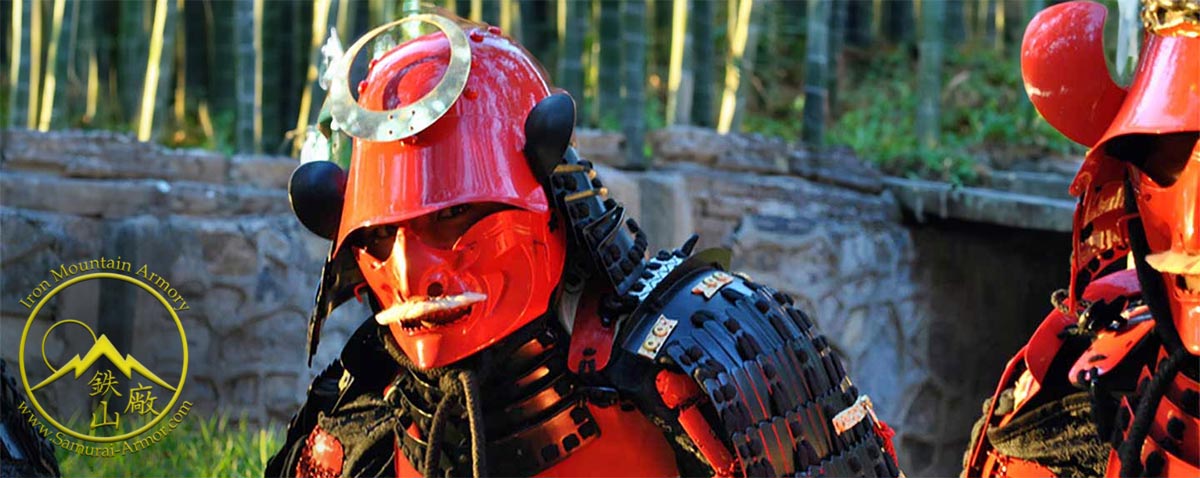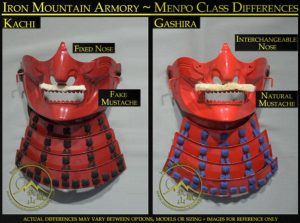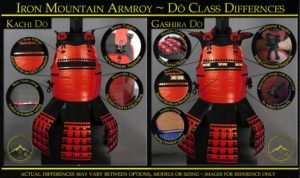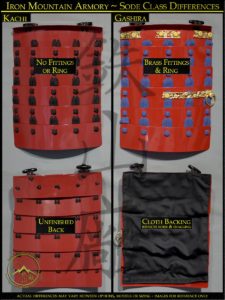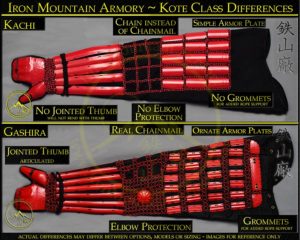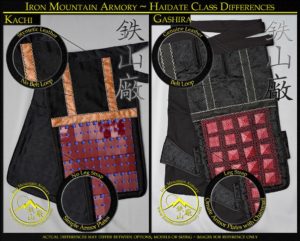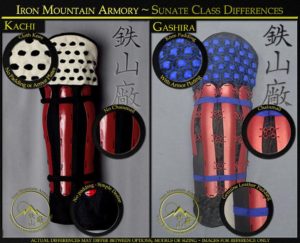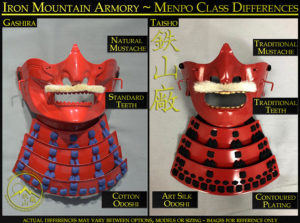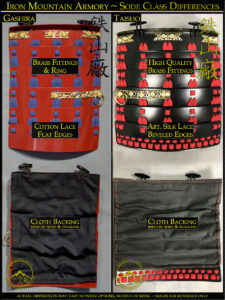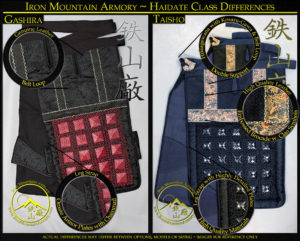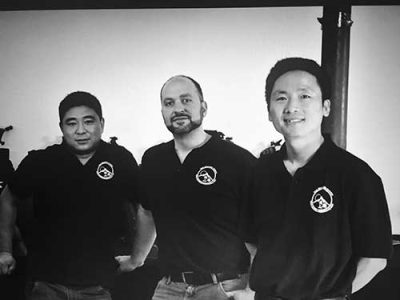Listed below are the major differences between our Kachi and Gashira Class Gendai Samurai Armor crafted by Iron Mountain Armory. This is followed by comparisons between our Gashira and Taisho Class armor pieces.
Please review all the details below and contact us if you have any questions or concerns.
Kachi Class VS Gashira Class
MUSTACHES: Kachi class menpō’s can be ordered with or without a synthetic mustache. Gashira class menpō feature a traditional mustache made from natural hair, with a wider variety of options.
NOSE: The nose of Kachi class menpō cannot be removed from the mask. The Gashira are more traditional, featuring a removable nose for safety as well as ease of speaking, eating or drinking.
LACING: The Kachi Menpō have a basic cotton or synthetic odoshi on the tare (throat guard). The Gashira menpo feature high quality cotton odoshi on the tare.
HOOKS:
Gashira Class Menpō will always come with Ori-Kugi hooks on either side. These are used to help secure the mask when the kabuto is tied in place on the head. Kachi Class Menpō are not guaranteed to come with these hooks.
.
BRASS FITTINGS: Laced Kachi dō lack the the Brass Fittings that come with Gashira class dō.
GROMMETS: The Kachi dō’s do not come with brass ring supports for the holes in the armor. Gashira Class armor has a grommet to strengthen the holes and protect any lacing, as well as add embellishment to the armor.
HINGES: Kachi dō’s come with removable hinge pins on both sides, but they only have cords on one side. The Gashira dō features removable hinge pins as well, but they have an optional cord that can be used to secure the dō for a better fit if the hinge is removed.
LACING: Kachi dō’s use basic cotton or synthetic odoshi. Gashira dō’s use high quality cotton odoshi.
LINING: Kachi dō’s are lined along the inside with cloth. Gashira dō’s are lined along the inside with leather.
RIVETS: Raised Rivets cannot be guaranteed on Kachi Class dō’s. Extra care will be taken on rivet specifications if Gashira armors are ordered.
SHOULDER PADDING: Gashira Class dō’s come with extra shoulder padding for added comfort and protection. Kachi dō’s lack this. It can be ordered as a separate item for an additional fee.
TOGGLES: Kachi Class dō’s use plastic toggles on the armor. Gashira Class armors use more traditional toggles made from iron.
BRASS FITTINGS: Gashira Sode have decorative brass fittings at the top and sides. Kachi Sode do not come with these decorative fittings.
BRASS RINGS: Gashira Sode have decorative brass fittings along the side with holding rings. These rings will be fitted with a tasselled rope which ties to the back-side of the dō to secure the sode, keeping them from falling forward. These ropes are Red by default, or you can request gold or white in the order comment section and we will change them if available. Kachi Sode lack both of these features but can be added using advanced options on the order page.
CLOTH BACKING:
Kachi Sode come plain, and do not have a backing. Gashira Sode are backed in cloth, which strengthens the shoulder plates, as well as protecting other parts of the armor from scratching or snagging.
ARMOR PLATES:The armor plates on Kachi kote are plain, and often lack extra embossing or reliefs. Gashira Kote include these designs by default, adding extra depth and detailing.
CHAINMAIL: Kachi kote are made with simple chain and made to simulate real chainmail, while Gashira kote are made with traditional Japanese style chainmail. This provides extra protection and security.
ELBOW PROTECTOR: Gashira kote are crafted with an elbow protector mounted into the chainmail. These come in varying styles and sizes according to the Kote design, they also add extra durability to the sleeve. Kachi kote do not have these, and the elbow is instead covered by a continuation of the sleeve’s chain.
GROMMETS: Kachi kote are built solidly, but do not have the extra brass grommets that Gashira Class Kote have. They can also be used to replace or add extra roping to support the sleeve on the arms.
THUMB: Gashira kote are made with a jointed thumb guard, which adds flexibility to the hand section when gripping a weapon. Kachi kote lack this feature, and instead have a solid piece of metal covering the thumb.
ARMOR PLATES: The armor plates on Kachi haidate are plain, and often lack extra embossing or reliefs. Gashira haidate include these designs by default, adding extra depth and detailing. Gashira haidate also come in a wide variety if designs.
BELT LOOP: Gashira haidate are crafted with holes at the top of the apron for the himo (belt) to pass through. This helps keep the haidate from sagging down. The Kachi haidate lack this feature.
LEATHER: Kachi haidate are crafted with synthetic leather or printed cloth. Gashira Haidate are made with genuine leather or egawa (leather with painted designs).
LEG STRAP: Gashira Haidate come with a strap on the back of the apron to secure the haidate to the leg while running. Kachi Haidate don’t have this feature.
OTHER NOTES: Kachi class haidate only offer a basic style of plating where the Gashira style offers several varities of plating with or without chainmail.
CHAINMAIL:
Kachi Class Suneate have no chainmail.
Gashira suneate have chainmail linking the plates. This adds extra protection and detailing (depending on model).
KNEES:
Kachi Class Suneate have a simple cloth knee. Gashira Class Suneate have padded knees with extra armor plating inside and extra threading for added durability.
LACING:
Kachi Class – No threading around knee lacing. Thin lacing to tie suneate around the shin.
Gashira Class – Has extra threading on the hiza (knee) to support kikko (internal armor plates) and thicker lacing to tie the suneate to the shin.
PADDING:
Kachi Class – Made from simple cloth and lacks the extra padding.
Gashira Class – Features extra padding in knee, and has genuine leather at the base (depending on model).
Gashira Class VS Taisho Class
MUSTACHES: Gashira mustache’s are made from a strip of hair glued to the menpo. Taisho mustaches are made from pieces of hair glued together and then to the menpo piece by piece to ensure the best detail and longevity. This is also a more traditional Japanese method.
TEETH: Gashira menpo have standard teeth made from steel. These are often painted the color of the menpo. Taisho have more traditional teeth that can be left natural or painted.
PLATE STYLE: Gashira class has hanging tare (throat plates) which are flat steel plates. They are machine pressed to curve, matching your throat contour. Taisho tare plates are hand hammered and feature a bow curve with a full beveled edge to better match the natural throat contour and are a more traditional design.
LACING: Gashira tare are made with high quality cotton odoshi, while the Taisho tare is made with art. silk odoshi.
BRASS FITTINGS: Both Gashira and Taisho Sode have decorative brass fittings and rings, but the fittings on Taisho Sode are much higher quality and feature better detail work.
CRAFTING: The Gashira sode have flat strips of steel that are machine pressed creating a basic curve to contour your arm. The Taisho sode are hand hammered and feature a bow curve with traditional bevel edging.
CLOTH BACKING: Gashira Sode and Taisho Sode are both backed with cloth, which strengthen the shoulder plates, as well as protecting other parts of the armor from scratches.
LACING: Gashira Armor’s are made with high quality cotton odoshi. Taisho Class Armor is made with art. silk odoshi instead.
EDGING: The edge of the plates of Taisho Sode are bevelled. Gashira Sode plates are straight and flat.
ARMOR PLATES: The armor plates and chainmail of Taisho haidate are much higher quality and have more sophisticated details than those on Gashira haidate.
BELT LOOP: Gashira haidate have standard belt loops in the front. Taisho haidate have these same loops, but they also feature a “Hikiagewana” with “Sosaru-Gawa” which can be attached to the do (chest) in order to prevent the haidate from sagging.
Material: The Gashira haidate use standard brocade materials and leather, while Taisho haidate feature high quality egawa leather and beautiful brocades embossed with Clan Symbols.
LEG STRAP: Both Gashira and Taisho Haidate feature extra straps on the back section of each leg. This helps to secure them better to the wearer’s leg.
